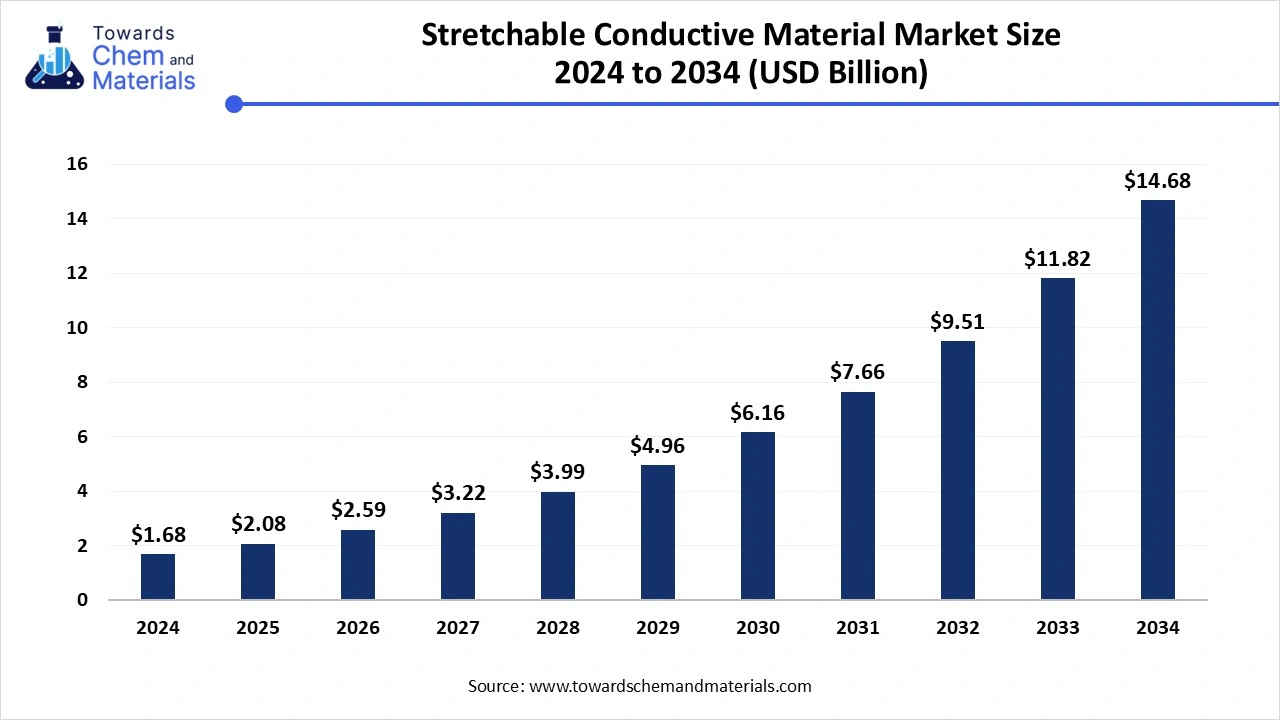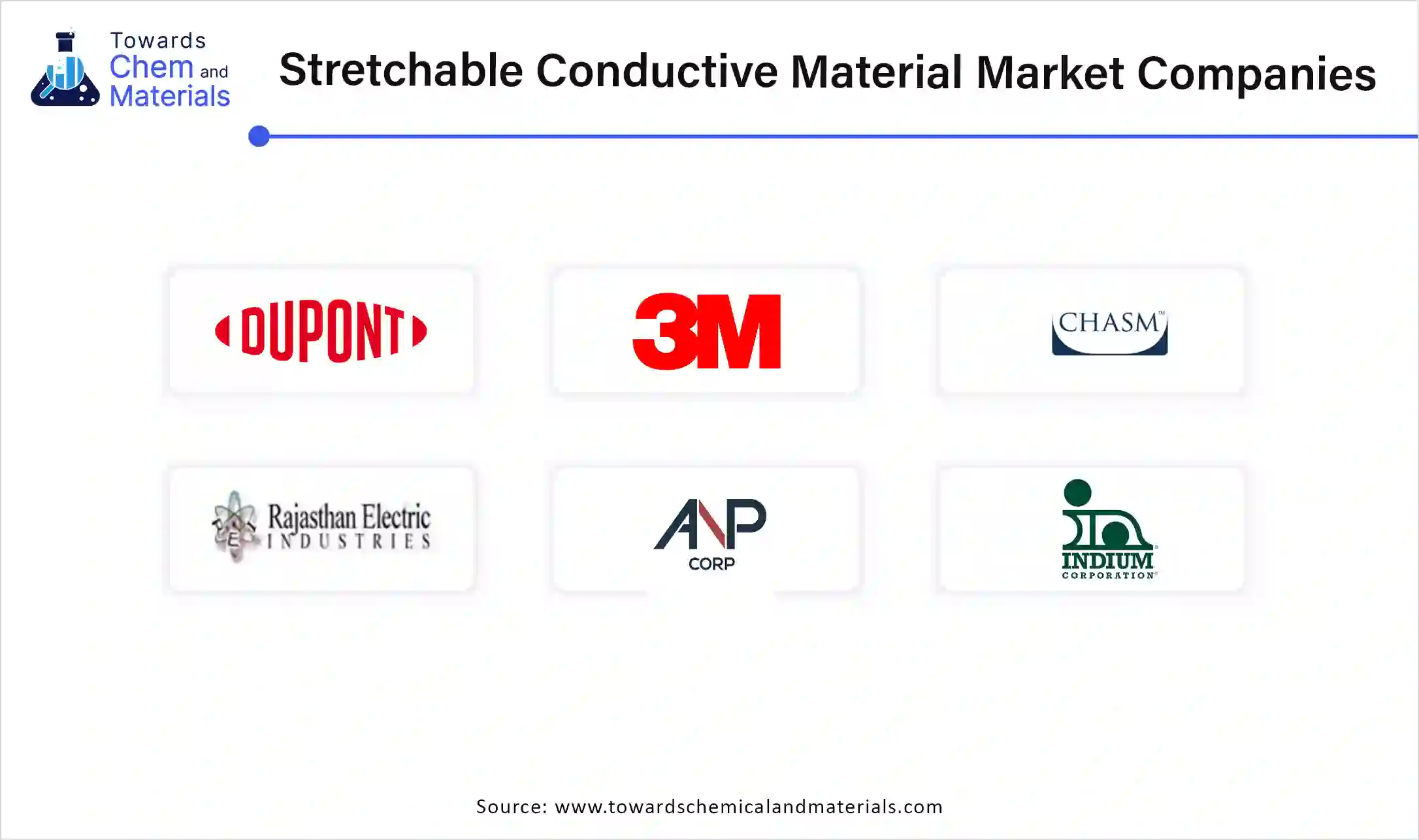April 2025
The global stretchable conductive material market size is expected to be worth around USD 14.68 billion by 2034 from USD 1.68 billion in 2024, growing at a CAGR of 24.23% during the forecast period 2025 to 2034. The market is emerging as a pivotal segment within advanced materials, driven by growing demand for flexible electronics, wearable devices, and soft robotics.

The stretchable conductive material market is gaining momentum as industries increasingly shift towards flexible, lightweight, and wearable electronics solutions. These materials, which maintain electrical conductivity while enduring mechanical deformation, are essential for next generation technologies in healthcare, consumer electronics, automative, and soft robotics. The market growth is primarily driven by rising adoption of wearable health monitors, smart textiles, electronic skin, and implantable devices, coupled with advances in material science enabling higher durability, sensitivity, and biocompatibility.
Growing investment is research and development, along with collaborations between tech firms and material scientist, are forecasting innovations in polymers, liquid metals, carbon nanotubes, and nanocomposites. Additionally, increased demand for human-machine interfaces and miniaturised medicine devices is further accelerating the global market trajectory.
However, challenges such as material stability, production scalability, and cost remain key areas for improvement. As industries strive for seamless integration of electronics with the human body and flexible surfaces, the stretchable conductive material market is poised to become a cornerstone of future electronic innovation.
| Report Attributes | Details |
| Market Size in 2025 | USD 2.08 Billion |
| Expected Size in 2034 | USD 14.68 Billion |
| Growth Rate | CAGR of 24.23% from 2025 to 2034 |
| Base Yaer of Estimation | 2024 |
| Forecast Period | 2025-2034 |
| Dominant Region | Asia Pacific |
| Segment Covered | By Product,Application,End User, Region |
| Key Companies Profiled | DuPont.,3M,CHASM,Rajasthan Electric Industries.,ANP CORPORATION.,Applied Nanotech, Inc.,Indium Corporation,Vorbeck Materials Corp., Dycotec Materials Ltd,Minco, |
The primary driver of the stretchable conductive material market is the rising demand for wearable and flexible electronics across healthcare, fitness, and consumer applications. As industries increasingly integrate smart textiles and electronic skin patches for real-time monitoring and user interaction, the need for materials that offer both high conductivity and mechanical flexibility is surging. This shift is further accelerated by advancements in nanotechnology, miniaturisation, and increased investment in next-generation materials by tech firms and research institutions globally.
A promising growth avenue is the emergence of graphene-based additives. Graphene offers superior electrical conductivity, expectational flexibility, and durability-qualities that significantly enhance that performance of stretchable materials. Ongoing innovations cantered around these advanced materials are opening new possibilities in industries such as healthcare, consumer electronics, and smart textiles.
One of the pressing challenges facing the stretchable conductive material market is the difficulty in integrating these materials into existing electronic frameworks. Ensuring compatibility with current system architectures, maintaining stable connections, and developing appropriate methods of assembly demand advanced design strategies and technical precision. These hurdles can delay product development cycles and restrict widespread commercial use which limits the expansion of the market.
Asia-pacific region dominated the stretchable conductive material market in 2024. The growth of the market is attributed due to its strong manufacturing capabilities, expanding electronics and wearables sector, and significant investments in research and development. The region benefits from cost-effective production and a large consumer base driving demand for flexible and stretchable technologies.
China and India are the leading countries, with China being a global hub for electronics manufacturing and India rapidly expanding its technological infrastructure and industrial base.
| By Region | Revenue Share 2024 (%) |
| Asia Pacific | 41.56% |
| North America | 24.19% |
| Europe | 18.85% |
| Latin America | 9.19% |
| Middle East and Africa | 6.21% |
North America is anticipated to have significant growth in the stretchable conductive material market in the forecasted period, due to increased adoption of smart wearables, advanced healthcare technologies, and the strong presence of key technology firms. Ongoing innovations, strategic partnerships, and robust funding for R&D further contribute to its accelerating growth.
The United States and Canada are the leading countries, with the U.S. spearheading innovation and product development in the medical and consumer electronics sectors.
Carbon nanotubes segment dominated the stretchable conductive material market in 2024. Their high aspect ratio and exceptional conductivity make them ideal for lightweight and stretchable electronics. As research advances and production costs decrease, CNTs are being increasingly adopted for next-generation devices, especially in biomedical applications and sensors, pushing this segment into a high-growth trajectory.
Graphene segment expects a significant growth in the market during the forecast period. The growth of the segment is attributed due to its extraordinary electrical conductivity, flexibility, and mechanical strength. Its ability to maintain performance under deformation makes it a preferred material in applications requiring high durability and performance consistency, such as smart textiles and skin-mounted electronics. The material's ease of integration with existing fabrication processes also contributes to its widespread adoption.
Wearable electronics segment dominated the market in 2024. From smartwatches and fitness bands to electronic textiles and health monitoring patches, the demand for comfortable, durable, and flexible electronics is soaring. These applications benefit from materials that can endure daily movements without compromising function, making stretchable conductors indispensable in this space.
The biomedical sector segment expects a significant growth in the stretchable conductive material market during the forecast period. The segment is driven by the increasing need for flexible, biocompatible materials used in real-time health monitoring, implantable devices, and electronic skin. Stretchable conductors enable better integration with the human body, offering new possibilities for non-invasive diagnostics, therapeutic wearables, and neurostimulation. Continued innovation and clinical trials are accelerating the adoption of these materials in medical technology.
The healthcare segment dominates the stretchable conductive market in 2024. The growth of the segment is owing to its widespread use in biomedical applications such as health devices, implantation sensors, and flexible diagnostics. The material's adaptability, biocompatibility, and superior conductivity make it ideal for medical uses that require seamless integration with the human body. Rising healthcare needs and demand for personalized medical technologies further contribute to this dominance.
The consumer electronics segment expects a significant growth in the stretchable conductive material market during the forecast period. The growth of the segment is attributed due to increasing popularity of smart wearables and flexible electronic device. As manufacturers strive to create more compact lightweight, and multifunctional gadgets, stretchable conductive materials are becoming critical for enabling innovation in product design and functionality.

April 2025
March 2025